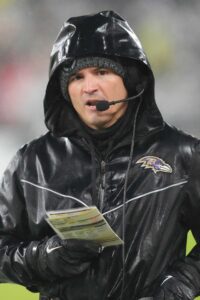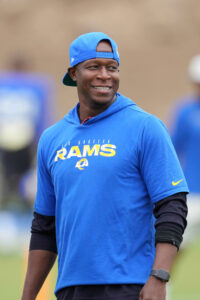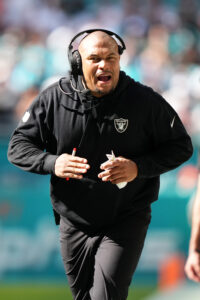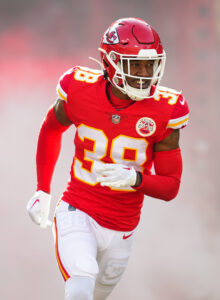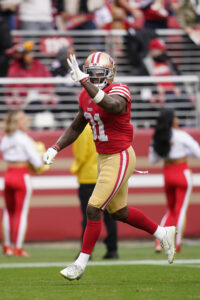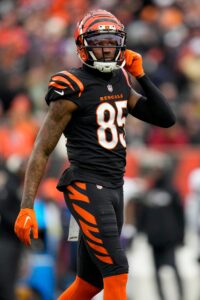After a crowded carousel previously stopped, the 49ers opened their defensive coordinator position. Here is how the NFC champions’ search looks:
Updated 3-2-24 (10:00am CT)
Offensive Coordinators
Atlanta Falcons (Out: Dave Ragone)
- Cortez Hankton, co-offensive coordinator (LSU): Interview requested
- Zac Robinson, quarterbacks coach (Rams): Hired
Buffalo Bills (Out: Ken Dorsey)
- Joe Brady, interim offensive coordinator/quarterbacks coach (Bills): Hired
- Thad Lewis, quarterbacks coach (Buccaneers): Interviewed
Carolina Panthers (Out: Thomas Brown)
- Marcus Brady, senior offensive assistant (Eagles): Interview requested
- Brad Idzik, wide receivers coach (Buccaneers): Hired
Chicago Bears (Out: Luke Getsy)
- Marcus Brady, senior offensive assistant (Eagles): Interview requested
- Thomas Brown, offensive coordinator (Panthers): Interviewed 1/17
- Liam Coen, offensive coordinator (Kentucky): Interviewed
- Kliff Kingsbury, senior offensive analyst (USC): Interviewed 1/18
- Klint Kubiak, pass-game coordinator (49ers): Interviewed
- Kellen Moore, offensive coordinator (Chargers): Interview blocked
- Greg Olson, quarterbacks coach (Seahawks): Interviewed
- Zac Robinson, quarterbacks coach (Rams): Interviewed
- Greg Roman, former offensive coordinator (Ravens): Interviewed
- Shane Waldron, offensive coordinator (Seahawks): Hired
Cincinnati Bengals (Out: Brian Callahan)
- Andy Dickerson, offensive line coach (Seahawks): To interview
- Dan Pitcher, quarterbacks coach (Bengals): Promoted
Cleveland Browns (Out: Alex Van Pelt)
- Andy Dickerson, offensive line coach (Seahawks): To interview
- Ken Dorsey, former offensive coordinator (Bills): Hired
- Brian Johnson, former offensive coordinator (Eagles): Interviewed 1/25
- Jerrod Johnson, quarterbacks coach (Texans): Interviewed 1/23
- Kellen Moore, offensive coordinator (Chargers): Interview requested; hired as Eagles OC
Las Vegas Raiders (Out: Mick Lombardi)
- Eric Bieniemy, offensive coordinator (Commanders): Spoke recently
- Luke Getsy, former offensive coordinator (Bears): Hired
- Chip Kelly, former head coach (Eagles/49ers): Interviewed twice
- Thad Lewis, quarterbacks coach (Buccaneers): Interview requested
- Kliff Kingsbury, senior offensive analyst (USC): Withdrew from consideration
- Klint Kubiak, pass-game coordinator (49ers): May interview; hired as Saints OC
- Dan Pitcher, quarterbacks coach (Bengals): To interview 1/24; hired as Bengals OC
- Zac Robinson, quarterbacks coach (Rams): Interview requested; hired as Falcons OC
- Mike Sullivan, quarterback coach (Steelers): Interviewed 1/25
- Alex Van Pelt, former offensive coordinator (Browns): Interviewed 1/25; hired as Patriots OC
- Shane Waldron, offensive coordinator (Seahawks): Mentioned as candidate; hired as Bears OC
Los Angeles Chargers (Out: Kellen Moore)
- Marcus Brady, senior offensive assistant (Eagles): Hired as pass-game coordinator
- Greg Roman, former offensive coordinator (Ravens): Hired
New England Patriots (Out: Bill O’Brien)
- Thomas Brown, offensive coordinator (Panthers): Interviewed
- Nick Caley, tight ends coach (Rams): Conducted second interview 1/29
- Tanner Engstrand, pass-game coordinator (Lions): Interviewed
- Brian Fleury, tight ends coach (49ers): Interviewed
- Luke Getsy, former offensive coordinator (Bears): Interviewed 1/30
- Klint Kubiak, passing game coordinator (49ers): Interviewed
- Dan Pitcher, quarterbacks coach (Bengals): Interviewed 1/23; hired as Bengals OC
- Zac Robinson, quarterbacks coach (Rams): Interview requested; hired as Falcons OC
- Scott Turner, passing game coordinator (Raiders): Interview expected
- Alex Van Pelt, former offensive coordinator (Browns): Hired
- Shane Waldron, offensive coordinator (Seahawks): Interviewed; hired as Bears OC
New Orleans Saints (Out: Pete Carmichael)
- Ronald Curry, quarterbacks coach (Saints): Interviewed
- Luke Getsy, former offensive coordinator (Bears): Conducted second interview 1/31
- Brian Griese, quarterbacks coach (49ers): Interviewed
- Brian Johnson, former offensive coordinator (Eagles): Interviewed 1/29
- Jerrod Johnson, quarterbacks coach (Texans): Conducted second interview 1/27
- Klint Kubiak, pass-game coordinator (49ers): Hired
- Greg Lewis, receivers coach (Ravens): To interview
- Dan Pitcher, quarterbacks coach (Bengals): Second interview on 1/24; hired as Bengals OC
- Zac Robinson, quarterbacks coach (Rams): Interviewed; hired as Falcons OC
- Mike Sullivan, quarterbacks coach (Steelers): To interview
- Shane Waldron, offensive coordinator (Seahawks): Interviewed; hired as Bears OC
Philadelphia Eagles (Out: Brian Johnson)
- Jerrod Johnson, quarterbacks coach (Texans): Interviewed
- Kliff Kingsbury, senior offensive analyst (USC): Interviewed 1/23
- Kellen Moore, offensive coordinator (Chargers): Hired
Pittsburgh Steelers (Out: Matt Canada)
- Thomas Brown, offensive coordinator (Panthers): Interviewed 1/24
- Jerrod Johnson, quarterbacks coach (Texans): Interviewed 1/26
- Zac Robinson, quarterbacks coach (Rams): Interview requested; hired as Falcons OC
- Arthur Smith, former head coach (Falcons): Hired
Seattle Seahawks (Out: Shane Waldron)
- Eric Bieniemy, former offensive coordinator (Commanders): Rumored candidate
- Tanner Engstrand, pass-game coordinator (Lions): Interview requested
- Ryan Grubb, offensive coordinator (Alabama): Expected to be hired
- Mike Kafka, offensive coordinator (Giants): Interview blocked
Tampa Bay Buccaneers (Out: Dave Canales)
- Liam Coen, offensive coordinator (Kentucky): Hired
- Ken Dorsey, former offensive coordinator (Bills): To interview
- Tanner Engstrand, pass-game coordinator (Lions): To interview
- Brian Johnson, former offensive coordinator (Eagles): Interviewed 1/30
- Jerrod Johnson, quarterbacks coach (Texans): Interviewed 1/30
- Thad Lewis, quarterbacks coach (Buccaneers): Interviewed 1/31
- Kellen Moore, offensive coordinator (Chargers): To interview 1/29; hired as Eagles OC
- Jake Peetz, pass-game specialist (Rams): Interviewed 2/1
- Antwaan Randle El, wide receivers coach (Lions): Interviewed 1/26
- Zac Robinson, quarterbacks coach (Rams): Interview requested; hired as Falcons OC
- John Van Dam, tight ends coach (Buccaneers): To interview
- Alex Van Pelt, former offensive coordinator (Browns): Interviewed 1/29
Tennessee Titans (Out: Tim Kelly)
- Nick Holz, passing game coordinator (Jaguars): Hired
- Thad Lewis, quarterbacks coach (Buccaneers): Interviewed
- Eric Studesville, associate head coach/running backs coach (Dolphins): Interview requested
Washington Commanders (Out: Eric Bieniemy)
- Chip Kelly, former head coach (Eagles/49ers): On team’s radar
- Kliff Kingsbury, senior offensive analyst (USC): Hired
Defensive Coordinators
Atlanta Falcons (Out: Ryan Nielsen)
- Sean Desai, former defensive coordinator (Eagles): To interview
- Aden Durde, defensive line coach (Cowboys): Interview requested
- Jimmy Lake, former head coach (Washington): Hired
Baltimore Ravens (Out: Mike Macdonald)
- Zach Orr, inside linebackers coach (Ravens): Promoted
Buffalo Bills
- Bobby Babich, linebackers coach (Bills): Promoted
- Mike Caldwell, former defensive coordinator (Jaguars): Interviewed
- Sean Desai, former defensive coordinator (Eagles): To interview
Chicago Bears (Out: Alan Williams)
- Joe Barry, former defensive coordinator (Packers): To interview 1/27
- Chris Harris, secondary coach (Titans): To interview
- Eric Washington, assistant head coach/defensive line coach (Bills): Hired
- Terrell Williams, assistant head coach/defensive line coach (Titans): To interview
Dallas Cowboys (Out: Dan Quinn)
- Aden Durde, defensive line coach (Cowboys): Interviewed 2/6
- Al Harris, cornerbacks coach (Cowboys): Mentioned as candidate
- Marquand Manuel, safeties coach (Jets): To interview 2/8
- Ron Rivera, former head coach (Commanders): Interviewed 2/5
- Rex Ryan, former head coach (Bills): Interviewed; team still interested
- Joe Whitt, defensive backs coach (Cowboys): Frontrunner?; hired as Commanders DC
- Mike Zimmer, former head coach (Vikings): Hired
Green Bay Packers (Out: Joe Barry)
- Bobby Babich, linebackers coach (Bills): To interview; hired as Bills DC
- Aden Durde, defensive line coach (Cowboys): Interview requested
- Ejiro Evero, defensive coordinator (Panthers): Rumored candidate
- Jeff Hafley, head coach (Boston College): Hired
- Chris Harris, secondary coach (Titans): Rumored candidate
- Zach Orr, linebackers coach (Ravens): Interviewed 1/31
- Christian Parker, defensive backs coach (Broncos): Interviewed 1/25
- Aubrey Pleasant, defensive backs coach (Rams): Rumored candidate
- Brandon Staley, former head coach (Chargers): Interviewed 1/26
- Dennard Wilson, defensive backs coach (Ravens): Interview requested
Jacksonville Jaguars (Out: Mike Caldwell)
- Shane Bowen, defensive coordinator (Titans): Interviewed
- Ejiro Evero, defensive coordinator (Panthers): Interview blocked
- Chris Harris, defensive backs coach (Titans): Interviewed
- Chris Hewitt, pass-game coordinator (Ravens): Interviewed
- Marquand Manuel, safeties coach (Jets): Interviewed 1/18
- Don Martindale, former defensive coordinator (Giants): Interviewed 1/16-1/17
- Ryan Nielsen, defensive coordinator (Falcons): Hired
Los Angeles Chargers (Out: Derrick Ansley)
- Jesse Minter, defensive coordinator (Michigan): Hired
Los Angeles Rams (Out: Raheem Morris)
- Aden Durde, defensive line coach (Cowboys): Interview requested
- Ejiro Evero, defensive coordinator (Panthers): Mentioned as candidate
- Aubrey Pleasant, defensive backs coach (Rams): Expected to interview
- Ron Rivera, former head coach (Commanders): Interviewed
- Chris Shula, inside linebackers coach (Rams): Promoted
- Brandon Staley, former head coach (Chargers): Interviewed 1/30
- Dennard Wilson, defensive backs coach (Ravens): To interview
Miami Dolphins (Out: Vic Fangio)
- Bobby Babich, linebackers coach (Bills): Interview requested
- Anthony Campanile, inside linebackers coach (Dolphins): Interviewed
- Ejiro Evero, defensive coordinator (Panthers): Interview blocked
- Leslie Frazier, former defensive coordinator (Bills): Interviewed 1/30
- Chris Kiffin, linebackers coach (Texans): To interview
- Chris Shula, linebackers coach/pass-rush coordinator (Rams): To interview 2/1
- Ryan Slowik, outside linebackers coach (Dolphins): Interview expected
- Brandon Staley, former head coach (Chargers): Interviewed
- Anthony Weaver, defensive line coach (Ravens): Hired
New England Patriots
- DeMarcus Covington, defensive line coach (Patriots): Promoted
- Michael Hodges, linebackers coach (Saints): To interview
- Tem Lukabu, outside linebackers coach (Panthers): To interview
- Christian Parker, defensive backs coach (Broncos): Interviewed
New York Giants (Out: Don Martindale)
- Derrick Ansley, defensive coordinator (Chargers): Interviewed
- Bobby Babich, linebackers coach (Bills): Interview requested; promoted to Bills DC
- Shane Bowen, defensive coordinator (Titans): To be hired
- Anthony Campanile, linebackers coach (Dolphins): Interview requested
- Brendan Daly, linebackers coach (Chiefs): Interviewed
- Ejiro Evero, defensive coordinator (Panthers): Interview blocked
- Daronte Jones, defensive pass game coordinator (Vikings): Interviewed
- Dennard Wilson, defensive backs coach (Ravens): To conduct second interview; hired as Titans DC
Philadelphia Eagles (Out: Sean Desai)
- Mike Caldwell, former defensive coordinator (Jaguars): Interviewed
- Vic Fangio, former defensive coordinator (Dolphins): Hired
- Ron Rivera, former head coach (Commanders): Interviewed 1/22
San Francisco 49ers (Out: Steve Wilks)
- Gerald Alexander, safeties coach (Raiders): Interviewed 3/1
- Daniel Bullocks, defensive backs coach (49ers): Interviewed 2/28
- David Merritt, defensive backs coach (Chiefs): To interview
- Nick Sorensen, defensive passing game specialist (49ers): Promoted
- Brandon Staley, former head coach (Chargers): Interviewed
Seattle Seahawks (Out: Clint Hurtt)
- Joe Cullen, defensive line coach (Chiefs): Mentioned as candidate
- Aden Durde, defensive line coach (Cowboys): Hire expected
Tennessee Titans (Out: Shane Bowen)
- Brandon Lynch, cornerbacks coach (Browns): Interviewed 1/30
- Dennard Wilson, defensive backs coach (Ravens): Hired
Washington Commanders (Out: Jack Del Rio)
- Joe Cullen, defensive line coach (Chiefs): Considered a candidate
- Joe Whitt, defensive backs coach (Cowboys): Hired
